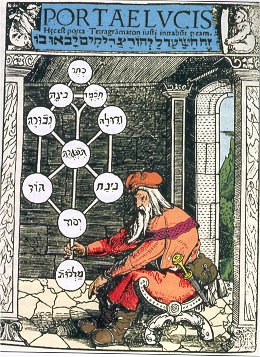 |
| The Medieval era began esoteric circles of Kabbalistic dissemination in French Provence, Andalusian Spain and Germany-Ashkenaz (Photo credit: Wikipedia) |
According to Kabbalah tradition, the first man was a Mekubal, as were Abraham, Issac, Jacob and many others. Among the more noted of the Kabbalah books, you can find the Book of the Angel Raziel, which belonged to Adam, and to the Book of Creation, which is ascribed to Abraham, followed by the Book of Zohar, which was written by Rabbi Shimon Bar Yochai. As a matter of fact, there is no way to determine the true author of these books.
Historical Development
You need to differentiate between Kabbalistic research and Kabbalistic faith. According to faith, Kabbalah began with Adam, the first Man. Research puts the origins of Kabbalah at around 1,000 years ago, with written material appearing at around the 12 century in Spain. By this division, the entire Ashkenazi lore isn't part of the Kabbalah. The Mekubalim don't recognize this distinction, and according to them, 'Kabbalah' contains all Jewish Mystic Lore.
The Kabbalah has roots in the Second Temple period, with various texts attributed to Chazal and the Gaonim. During this time, learning the Kabbalah was limited to Jews over the age of 40, with some stipulating that it shouldn't be taught at all.
Towards the end of the 10th century, with Greek and Arab philosophy influences, the Kabbalah withdrew from the limelight.
Towards the end of the 12th century, the first book of Kabbalah appeared in Provance, France. This book was attributed to the Chachami Mishna, and named 'The Bright Book'. This book is considered the cornerstone of Kabbalistic lore. The book contains a number of sermons, with the most important writing being The Book of Creation. The Book of Creation appears to be older, however, it is probable that the Book of Creation is a collection of stories and writings that predated The Bright Book. The Book of Creation is unique in that it describes the creation of the world and the souls by God. This book also serves as the base for Practical Kabbalah, as it is specifically mentioned that the soul is created by 22 letters, and from this, the use of amulets and name change to change a person's life began.
From Provance, the Kabbalah spread throughout the whole Jewish world.
After Provance, Italy became the world center for Kabbalah, and around that time appeared the first copies of the Book of Zohar. Again, academic research and belief differ here, as academics attribute this book to Moses Di Lion, whereas tradition attributes the book to Rabbi Shimon Bar Yochai. The book wasn't widely known, but after the Jews were expelled from Spain it was re-discovered, and ever since then is the most influential book of the Kabbalah.
In the 15th century, the center of Kabbalah moved again, this time to Safed, where the Kabbalah began spreading to the common folk as well. The Kaballah influenced Rabbis and poets, and so became an inseparable part of the Jewish spirit.
As a result of the Kabbalah, all sorts of self-appointed doomsday prophets started up, however they didn't amount to very much. during this time, Israel became the spiritual center for the Jewish people, and the tradition of visiting the graves of Tsadikim was begun by Mekubalim, who came to Israel to visit the graves of the Mishna and Zohar scholars buried in Safed.
Students of the Kabbalah in general and specifically, the Ari Kabbalah, left Israel and spread the lore to everywhere there were Jews. The Kabbalah was a great influence on the Jews in the East and North Africa, where it became accessible to all, not just the learned and scholars. This led to Practical Kabbalah being developed to a far greater extent in North Africa, as opposed to Europe and Israel.
From the 17th century onwards, people dealt with the Kabbalah less and less, but there were still Talmudic students and Rabbis who continued studying the lore, which now, as then, is still based on two central books. The Book of Zohar, and the Talmud. Nowadays, Kabbalah is becoming popular again, with the influx of celebrities such as Madonna reviving the interest in the Jewish lore.
Article Source: EzineArticles |

No comments:
Post a Comment